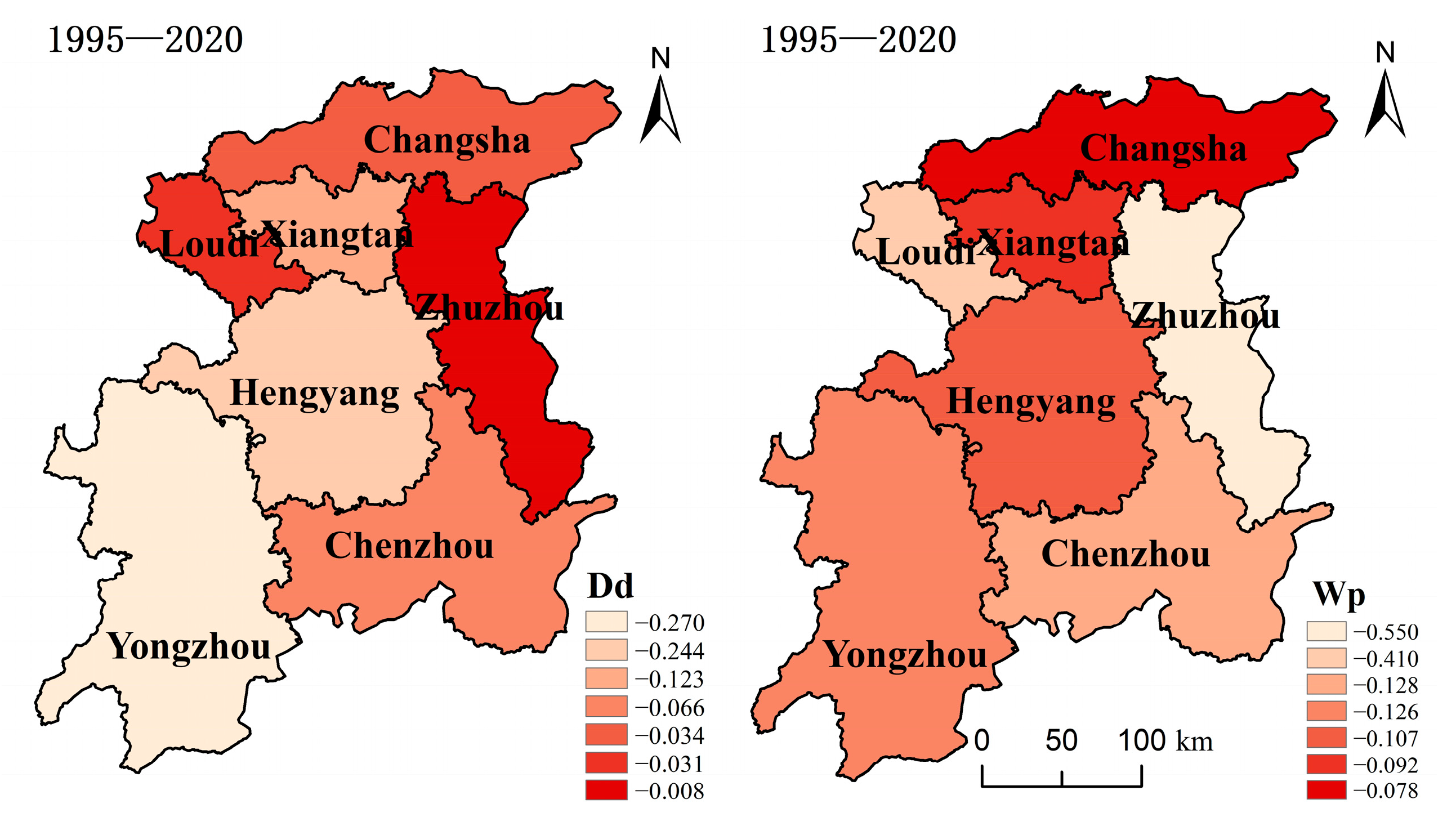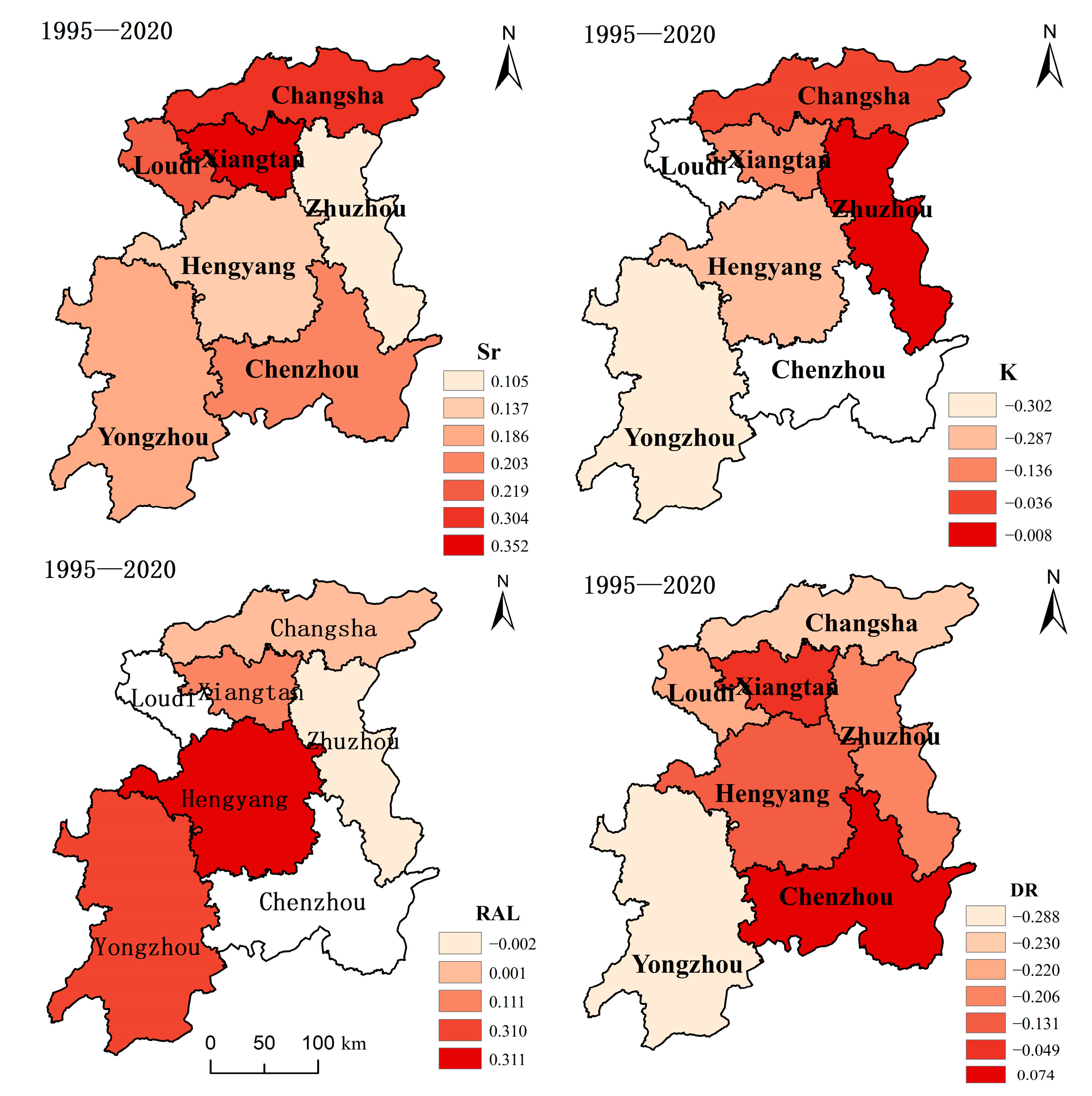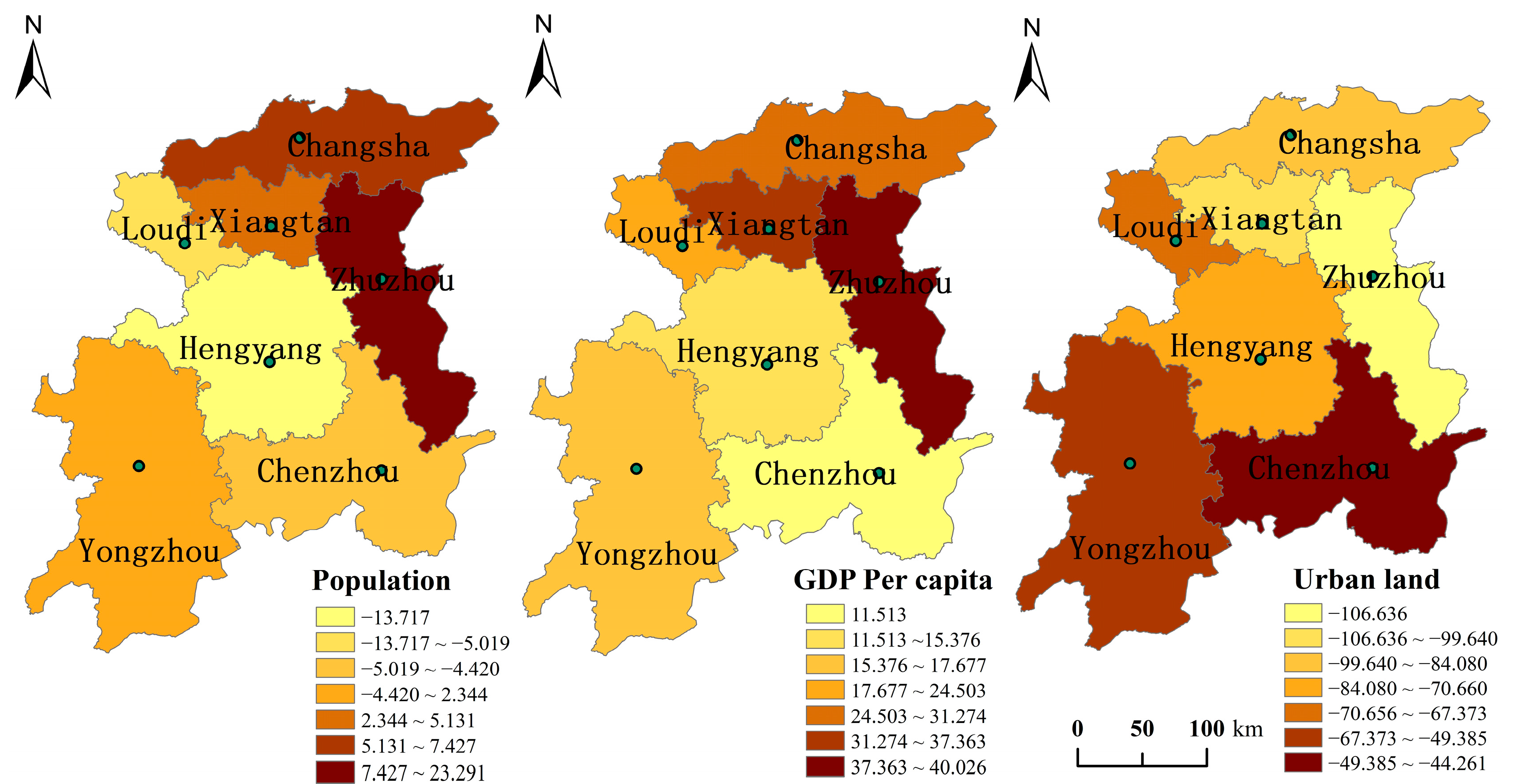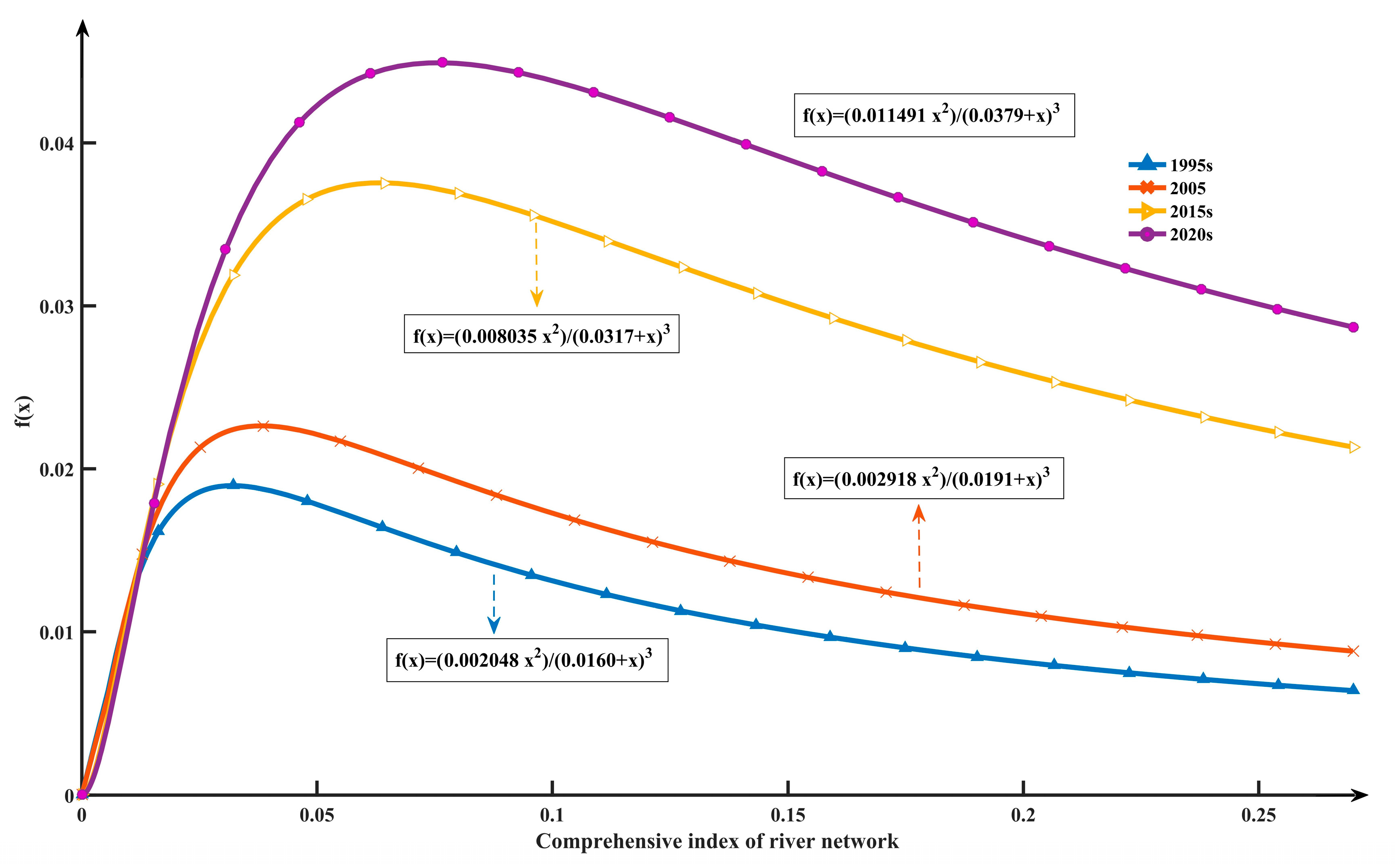Study on the Evolution and Adaptability of the River Network System under Rapid Urbanization in the Xiangjiang River Basin, China
Abstract
:1. Introduction
2. Study Area
3. Research Data and Methods
3.1. Research Data
3.2. Comprehensive Evaluation Method for the Evolutionary Characteristics of River Network Systems
3.3. GTWR Model
3.4. Coherence Model
4. Results and Discussion
4.1. Spatial and Temporal Land Use/Cover Changes and Shifts in the Xiangjiang River Basin
4.2. Characteristics of the Evolution of the Xiangjiang River Basin River Network System
4.2.1. Evolution of the Quantitative Characteristics of the River Network System
4.2.2. Evolution of the Morphological Characteristics of the River Network System
4.3. Adaptation of River Network Systems in the Xiangjiang River Basin in the Context of Urbanization
4.3.1. Response of River Network Systems to Urbanization
4.3.2. Optimum Harmony between Town and River Network System
5. Conclusions
Author Contributions
Funding
Data Availability Statement
Acknowledgments
Conflicts of Interest
References
- World Cities Report 2022 Envisaging the Future of Cities; United Nations Human Settlements Programme: Nairobi, Kenya, 2022; pp. 1–387.
- Dottori, F.; Mentaschi, L.; Bianchi, A.; Alfieri, L.; Feyen, L. Cost-effective adaptation strategies to rising river flood risk in Europe. Nat. Clim. Chang. 2023, 13, 196–202. [Google Scholar] [CrossRef]
- Habersack, H.; Haspel, D.; Kondolf, M. Large Rivers in the Anthropocene: Insights and tools for understanding climatic, land use, and reservoir influences. Water Resour. Res. 2014, 50, 3641–3646. [Google Scholar] [CrossRef]
- Jiang, S.H.; Zhou, L.; Ren, L.L.; Wang, M.H.; Xu, C.Y.; Yuan, F.; Liu, Y.; Yang, X.L.; Ding, Y. Development of a comprehensive framework for quantifying the impacts of climate change and human activities on river hydrological health variation. J. Hydrol. 2021, 600, 126566. [Google Scholar] [CrossRef]
- Song, X.P.; Hansen, M.C.; Stehman, S.V.; Potapov, P.V.; Tyukavina, A.; Vermote, E.F.; Townshend, J.R. Global land change from 1982 to 2016. Nature 2018, 560, 639–643. [Google Scholar] [CrossRef] [PubMed]
- Wang, H.; He, G. Rivers: Linking nature, life, and civilization. River 2022, 1, 25–36. [Google Scholar] [CrossRef]
- Copenhagen, W.J. Adaptability of the Natal Crawfish. Nature 1933, 132, 354. [Google Scholar] [CrossRef]
- Bloschl, G.; Kiss, A.; Viglione, A.; Barriendos, M.; Bohm, O.; Brazdil, R.; Coeur, D.; Demaree, G.; Llasat, M.C.; Macdonald, N.; et al. Current European flood-rich period exceptional compared with past 500 years. Nature 2020, 583, 560–566. [Google Scholar] [CrossRef]
- Kreibich, H.; Van Loon, A.F.; Schroter, K.; Ward, P.J.; Mazzoleni, M.; Sairam, N.; Abeshu, G.W.; Agafonova, S.; AghaKouchak, A.; Aksoy, H.; et al. The challenge of unprecedented floods and droughts in risk management. Nature 2022, 608, 80–86. [Google Scholar] [CrossRef]
- Elmore, A.J.; Kaushal, S.S. Disappearing headwaters: Patterns of stream burial due to urbanization. Front. Ecol. Environ. 2008, 6, 308–312. [Google Scholar] [CrossRef]
- Han, L.F.; Xu, Y.P.; Lei, C.G.; Yang, L.; Deng, X.J.; Hu, C.S.; Xu, G.L. Degrading river network due to urbanization in Yangtze River Delta. J. Geogr. Sci. 2016, 26, 694–706. [Google Scholar] [CrossRef]
- Song, S.; Lin, Z.; Wang, Y.F.; Li, G.; Deng, X.J. The response of river network structure to urbanization: A multifractal perspective. J. Clean. Prod. 2019, 221, 377–388. [Google Scholar] [CrossRef]
- Wang, H.X.; Huang, L.T.; Hu, J.W.; Yang, H.; Guo, W.X. Effect of Urbanization on the River Network Structure in Zhengzhou City, China. Int. J. Environ. Res. Public Health 2022, 19, 2464. [Google Scholar] [CrossRef] [PubMed]
- Xu, G.L.; Li, A.J.; Yang, Q.Q.; Chi, J.Y. Spatiotemporal change in the river network in rapidly urbanized plain regions of the Yangtze River Delta in China. River Res. Appl. 2022, 38, 965–974. [Google Scholar] [CrossRef]
- Kang, C.S.; Kanniah, K.D. Land use and land cover change and its impact on river morphology in Johor River Basin, Malaysia. J. Hydrol. Reg. Stud. 2022, 41, 101072. [Google Scholar] [CrossRef]
- Tang, W.; Xu, Y.J.; Ni, M.F.; Li, S.Y. Land use and hydrological factors control concentrations and diffusive fluxes of riverine dissolved carbon dioxide and methane in low-order streams. Water Res. 2023, 231, 119615. [Google Scholar] [CrossRef]
- Wang, Q.; Xu, Y.P.; Xu, Y.; Wu, L.; Wang, Y.F.; Han, L.F. Spatial hydrological responses to land use and land cover changes in a typical catchment of the Yangtze River Delta region. Catena 2018, 170, 305–315. [Google Scholar] [CrossRef]
- Zhang, X.Y.; Li, F.W.; Zhao, Y. Impact of changes in river network structure on hydrological connectivity of watersheds. Ecol. Indic. 2023, 146, 109848. [Google Scholar] [CrossRef]
- Deng, X.J.; Xu, Y.P.; Han, L.F.; Song, S.; Xu, G.L.; Xiang, J. Spatial-temporal changes in the longitudinal functional connectivity of river systems in the Taihu Plain, China. J. Hydrol. 2018, 566, 846–859. [Google Scholar] [CrossRef]
- Yang, L.; Xu, Y.P.; Han, L.F.; Song, S.; Deng, X.J.; Wang, Y.F. River networks system changes and its impact on storage and flood control capacity under rapid urbanization. Hydrol. Process. 2016, 30, 2401–2412. [Google Scholar] [CrossRef]
- Liu, S.; Lin, M.N.; Li, C.L. Analysis of the Effects of the River Network Structure and Urbanization on Waterlogging in High-Density Urban Areas-A Case Study of the Pudong New Area in Shanghai. Int. J. Environ. Res. Public Health 2019, 16, 3306. [Google Scholar] [CrossRef]
- Han, L.F.; Xu, Y.P.; Deng, X.J.; Li, Z.W. Stream loss in an urbanized and agricultural watershed in China. J. Environ. Manag. 2020, 253, 109687. [Google Scholar] [CrossRef] [PubMed]
- Du, L.J.; Wang, F.; Zhang, Q.X.; Fang, Y.Y. Adaptation of urban distribution to the fluvial geomorphic environment and the reconstruction of the river system structure by urban distribution in Haihe Plain in the past 2200 years. River Res. Appl. 2021, 39, 1199–1211. [Google Scholar] [CrossRef]
- Yang, S.T.; Pan, Z.H.; Lou, H.Z.; Li, C.J.; Zhang, J.; Zhang, Y.J.; Yi, Y.; Gong, J.Y.; Luo, Y.; Zhi, M.; et al. Reconstruction of the water cycle process reveals the 600-year evolution of the human-water relationship in Tunpu, China. J. Hydrol. 2023, 617, 128927. [Google Scholar] [CrossRef]
- Lei, C.G.; Wang, Q.; Wang, Y.; Han, L.F.; Yuan, J.; Yang, L.; Xu, Y.P. Spatially non-stationary relationships between urbanization and the characteristics and storage-regulation capacities of river systems in the Tai Lake Plain, China. Sci. Total Environ. 2022, 824, 153684. [Google Scholar] [CrossRef] [PubMed]
- Brunsdon, C.; Fotheringham, A.S.; Charlton, M. Geographically weighted regression A method for exploring spatial nonstationarity. Geogr. Anal. 1996, 28, 281–298. [Google Scholar] [CrossRef]
- Fotheringham, A.S.; Charlton, M.E. Geographically weighted regression a natural evolution of the expansion method for spatial data analysis. Environ. Plan. A 1998, 30, 1905–1927. [Google Scholar] [CrossRef]
- Chen, Y.Z.; Zhou, G.H.; Wang, H.; Cui, S.Q.; Bi, F.Z.; Yu, X.X. The Evolution Characteristics and Enhancement Paths of the Economy-Society-Ecology Coordinated Development Level of Changsha-Zhuzhou-Xiangtan Urban Agglomeration. Trop. Geo. 2023, 43, 519–531, (In Chinese with English abstract). [Google Scholar] [CrossRef]
- Yang, K.; Yuan, W.; Zhao, J.; Xu, S.Y. Stream Structure Characteristic and Its Urbanization Responses to Tidal River System. Acta Ecol. Sin. 2004, 59, 557–564, (In Chinese with English abstract). [Google Scholar]
- Yuan, W.; Yang, K.; Wu, J.P. River Structure Characteristics and Classification System in River Network Plain During the Course of Urbanization. Sci. Geogr. Sin. 2007, 27, 401–407, (In Chinese with English abstract). [Google Scholar]
- Zhao, J.; Shan, F.Z.; Yang, K.; Wu, E.N. River sinuosity in tidal plain and its response to rapid urbanization. Adv. Water Sci. 2011, 22, 631–637, (In Chinese with English abstract). [Google Scholar] [CrossRef]
- Mueller, J.E. An Introduction to hydraulic and topographic sinuosity index. J. Assoc. Am. Geogr. 1968, 58, 371–385. [Google Scholar] [CrossRef]
- Wu, L.; Xu, Y.P.; Xu, Y.; Yuan, J.; Xiang, J.; Xu, X.; Xu, Y. Impact of rapid urbanization on river system in a river network plain. Acta Ecol. Sin. 2018, 73, 104–114, (In Chinese with English abstract). [Google Scholar] [CrossRef]
- Xu, G.L.; Xu, Y.P.; Wang, L.Y. Temporal and spatial changes of river systems in HangzhouJiaxing-Huzhou Plain during 1960–2000s. Acta Ecol. Sin. 2013, 68, 966–974, (In Chinese with English abstract). [Google Scholar]
- Yu, M.J. Changes of River System and Hydrological Process under the Impacts of Urbanization—A Case Study in Yinfeng Plain, Yongjiang River Basin, China; Nanjing University: Nanjing, China, 2013; pp. 1–88, (In Chinese with English abstract). [Google Scholar]
- Bai, Y.; Wu, L.X.; Qin, K.; Zhang, Y.F.; Shen, Y.Y.; Zhou, Y. A Geographically and Temporally Weighted Regression Model for Ground-Level PM2.5 Estimation from Satellite-Derived 500 m Resolution AOD. Remote Sens. 2016, 8, 262. [Google Scholar] [CrossRef]
- Hu, J.Y.; Liu, B.J. Analysis of River Network Changes Based on Spatial Auto-regression and Geographic Weighted Regression Model. J. China Hydrol. 2019, 39, 7–13, (In Chinese with English abstract). [Google Scholar]
- Xu, Y.; Xu, Y.P.; Wang, Q.; Wu, L.; Yang, J.Y.; Shi, H.Y. Relationship between urbanization and river network change in Taihu Lake basin, China. Adv. Water Sci. 2018, 29, 473–481, (In Chinese with English abstract). [Google Scholar]
- Huang, B.; Wu, B.; Barry, M. Geographically and temporally weighted regression for modeling spatio-temporal variation in house prices. Int. J. Geogr. Inf. Sci. 2010, 24, 383–401. [Google Scholar] [CrossRef]
- Li, Y.F.; Li, Y.; Zhou, Y.; Shi, Y.L.; Zhu, X.D. Investigation of a coupling model of coordination between urbanization and the environment. J. Environ. Manag. 2012, 98, 127–133. [Google Scholar] [CrossRef]
- Liu, Y.B.; Li, R.D.; Song, X.F. Analysis of Couping Degrees of Urbannization and Ecological Environment of China. J. Nat. Resour. 2005, 20, 105–112, (In Chinese with English abstract). [Google Scholar]
- Zhang, Y.; Yang, Z.F.; Li, W. Analyses of urban ecosystem based on information entropy. Ecol. Model. 2006, 197, 1–12. [Google Scholar] [CrossRef]
- Xiong, Y.; Zhang, F.M.; An, G.C.; Peng, L. Spatial-temporal Evolvement of Ecosystem Service Value in Hunan Province Based on LUCC. Resour. Environ. Yangtze Basin 2018, 27, 1397–1408, (In Chinese with English abstract). [Google Scholar]
- Peng, H.Z.; Zhou, G.H.; Cui, S.Q.; Shang, P. Evaluation and Obstacle Factor Identification of Multifunctionality of Land Use in Xiangjiang River Basin. Res. Soil. Water Conserv. 2022, 29, 308–315, (In Chinese with English abstract). [Google Scholar]
- Yuan, X.L.; Wang, C.; Li, B.Y.; Wang, W.; Chen, N.C. Review of the Driving Forces and Impacts of Land Use/Cover Change in the Yangtze River Basin. Geomat. Inf. Sci. Wuhan Univ. 2023, 48, 1241–1255, (In Chinese with English abstract). [Google Scholar]
- Yang, L.; Wang, C.Y.; Chang, F.; Li, H.Y.; Peng, L.L.; Xuan, R.Z. Four-dimensional assessment system for flood risks with the river network system evolution in Xiangjiang River Basin in Hunan of China. Trans. Chin. Soc. Agric. Eng. 2023, 39, 92–101, (In Chinese with English abstract). [Google Scholar]
- Xuan, R.Z.; Yang, L.; Feng, C.; Zhan, Q.; Hua, Y.Y.; Lv, L. Changes of River Network System in Midstream of Xiangjiang River and Its Response to Urban Expansion. Water Resour. Power 2023, 41, 30–33. [Google Scholar]
- Zhou, H.J.; Shi, P.J.; Wang, J.A.; Guo, L.; Zheng, J.; Yu, D.Y. River Network Change and Its Ecological Effects in Shenzhen Region in Recent 30 Years. Acta Geogr. Sin. 2008, 63, 969–980, (In Chinese with English abstract). [Google Scholar]
- Deng, X.J.; Xu, Y.P.; Han, L.F.; Li, G.; Wang, Y.F.; Xiang, J.; Xu, G.L. Spatial-temporal changes of river systems in Jiaxing under the background of urbanization. Acta Ecol. Sin. 2016, 71, 75–85, (In Chinese with English abstract). [Google Scholar] [CrossRef]
- Xu, H.Y.; Liu, L.; Ding, P.; Moller, M.S. Applying Ecosystem-Based Adaptation (EbA) in Multiple Scale Cooperative Stormwater Management in Climate Change Adaptation City: Case from Copenhagen. Landsc. Archit. 2022, 29, 53–66, (In Chinese with English abstract). [Google Scholar]
- Chen, S.C.; Liu, X.M. Analysis of Rainwater Garden Design in the Background of Sponge City: A case study of Ningbo Ecological Corridor. Contemp. Hortic. 2020, 7, 1–3, (In Chinese with English abstract). [Google Scholar]
- Gong, J.X.; Zou, B.; Liu, X.Q. Spatio-temporal differentiation of urbanization in the Xiangjiang Valley from 1990 to 2010. Resour. Sci. 2016, 38, 1723–1732, (In Chinese with English abstract). [Google Scholar]
- Liu, Y.B.; Li, R.D.; Song, X.F. Grey Associative Analysis of regional Urbanization and Eco-environment Coupling in China. Acta Geogr. Sin. 2005, 60, 237–247, (In Chinese with English abstract). [Google Scholar]
- Yang, L. Impact of Urbanization on River Networks System and Its Storage Flood Control Capacity in the Typical Areas of Yangtze River Delta: A Case Study of River Network Region in Suzhou; Nanjing University: Nanjing, China, 2017; pp. 1–122. [Google Scholar]
- Deng, X.J.; Xu, Y.P.; Han, L.F.; Yu, Z.H.; Yang, M.N.; Pan, G.B. Assessment of river health based on an improved entropy-based fuzzy matter-element model in the Taihu Plain, China. Ecol. Indic. 2015, 57, 85–95. [Google Scholar] [CrossRef]
- Jin, S.; Liu, Y.X.; Fagherazzi, S.; Mi, H.; Qiao, G.; Xu, W.X.; Sun, C.; Liu, Y.C.; Zhao, B.X.; Fichot, C.e.G. River body extraction from sentinel-2A/B MSI images based on an adaptive multi-scale region growth method. Remote Sens. Environ. 2021, 255, 112297. [Google Scholar] [CrossRef]







| Data Name | Data Sources | Data Processing | Data Results |
|---|---|---|---|
| River network system | Geospatial Data Cloud 95/05/15/20 four-phase 30 m resolution remote sensing image map | The acquired remote sensing images are subjected to pre-processing steps such as radiometric calibration, atmospheric correction, and image mosaic in ENVI. Manual calibration is performed based on Google HD resolution images. | Obtained a four-phase river network system map, divided into main streams, primary rivers, secondary rivers, and tertiary rivers. All the main streams and tributaries include line and plane elements, and the total number is 48. |
| Land use | CAS Resource and Environmental Science and Data Centre 95/00/05/10/15/20 Six phases of 30 m resolution land use imagery | Reclassification and fusion of images with ArcMap. | Classified into six types: arable land, forest land, grassland, water, urban land and unused land, and calculated land use transfer matrix. |
| Type of Indicator | Indicator Name and Formula | Formula Meaning | Physical Significance |
|---|---|---|---|
| Indicators of quantitative characteristics | River network density (Dd) [29] Dd = LR/A | LR: Total length of river (km) A: Total watershed area (km2) | The greater the value, the greater the regional storage capacity and vice versa |
| Water surface rate (Wp) [30] Wp = (Aw/A) × 100% River Frequency (Fr) [31] Fr = N/A | Aw: Total area of rivers and lakes (km2) N: Number of rivers in the region | Total area of rivers and lakes in the basin as a proportion of the total area of the basin Indicates the development of the number of rivers | |
| Morphological and structural indicators | Curvature of the river network (Sr) [32] Sr = L/Ls Tributary development factor (K) [33] K = LG/LT Dry flow area to length ratio (RAL) [34] RAL = AW/LT Structural stability (DR) [35] DR = LR/Aw | L: Straight-line distance between the start and end points of a river Ls: The length of the river LG: Total length of tributary LT: Total length of mainstream in km Ratio of mainstream area to main stream length LT: Main stream length Ratio of the total length of the corresponding class of river to the total area of the river | The ratio of the actual length of a river network to the shortest distance between its two endpoints, reflecting the natural curvature of the river network Indicates the extent of tributary development Reflects the overflow capacity of the river network cross-section Reflects the stability of the river network, its daily storage capacity, and its ability to withstand floods and droughts. A value less than 1 indicates that the area of the river is decaying faster than its length, while a value greater than 1 indicates the opposite |
Disclaimer/Publisher’s Note: The statements, opinions and data contained in all publications are solely those of the individual author(s) and contributor(s) and not of MDPI and/or the editor(s). MDPI and/or the editor(s) disclaim responsibility for any injury to people or property resulting from any ideas, methods, instructions or products referred to in the content. |
© 2023 by the authors. Licensee MDPI, Basel, Switzerland. This article is an open access article distributed under the terms and conditions of the Creative Commons Attribution (CC BY) license (https://creativecommons.org/licenses/by/4.0/).
Share and Cite
Yang, L.; Li, H.; Feng, C.; Peng, L.; Sun, R. Study on the Evolution and Adaptability of the River Network System under Rapid Urbanization in the Xiangjiang River Basin, China. Water 2023, 15, 3768. https://doi.org/10.3390/w15213768
Yang L, Li H, Feng C, Peng L, Sun R. Study on the Evolution and Adaptability of the River Network System under Rapid Urbanization in the Xiangjiang River Basin, China. Water. 2023; 15(21):3768. https://doi.org/10.3390/w15213768
Chicago/Turabian StyleYang, Liu, Huiyi Li, Chang Feng, Lulu Peng, and Ruisi Sun. 2023. "Study on the Evolution and Adaptability of the River Network System under Rapid Urbanization in the Xiangjiang River Basin, China" Water 15, no. 21: 3768. https://doi.org/10.3390/w15213768




